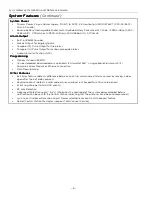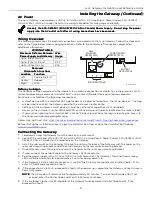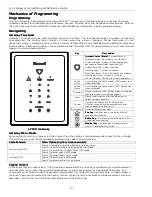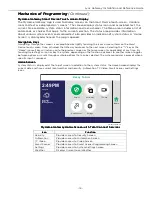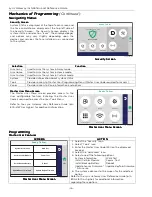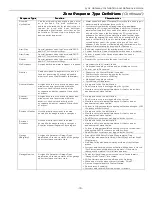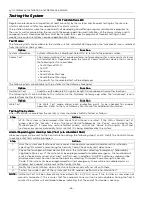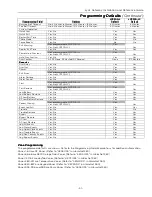
Lyric Gateway Installation and Reference Guide
- 18 -
Zone Response Type Definitions
Zone Response Type Definitions
Zone Response Type Definitions
Zone Response Type Definitions
General Information
General Information
General Information
General Information
During programming, you must assign a zone type to each zone, which defines the way in which the system
responds to faults in that zone. Zone types are defined below.
Response
Response
Response
Response Type
Type
Type
Type
Function
Function
Function
Function
Characteristics
Characteristics
Characteristics
Characteristics
Not Used
Used to program a zone that is not used.
•
None
Entry/Exit 1
(Burglary)
Usually assigned to sensors or contacts on
primary entry and exit doors.
•
Entry delay #1 is programmable.
•
Exit delay is independently programmable.
•
Exit and entry delays when armed in Away, Home (Stay),
Arm Night (Stay) or Armed Custom mode.
•
No entry delay when armed in Instant modes.
•
Exit delay begins regardless of the arming mode selected.
Entry/Exit 2
(Burglary)
Usually assigned to sensors or contacts on
secondary entry and exit doors that might
be further from the keypad (typically used
for a garage, loading dock, or basement
door).
•
Entry delay #2 is programmable.
•
Exit delay is independently programmable.
•
Secondary entry delay, if armed in the Away or Home (Stay)
mode.
•
No entry delay when armed in the Instant mode.
•
Exit delay begins regardless of the arming mode selected.
Perimeter
(Burglary)
Usually assigned to all sensors or contacts
on exterior doors and windows
•
Instant alarm, when armed in Away, Home (Stay), Home
(Stay) No Delay, Arm Night (Stay) or Away Instant mode.
Interior, Follower
Usually assigned to a zone covering an area
(i.e.: foyer, lobby, or hallway) that must be
passed upon entry (after faulting the
entry/exit zone) to reach the keypad.
Provides an instant alarm if the entry/exit
zone is not violated first, and protects an
area in the event an intruder has hidden on
the premises before the system is armed, or
gains access through an unprotected area.
•
Delayed alarm (using the programmed entry/exit time) if
entry/exit or interior-with-delay zone is faulted first.
•
Instant alarm in all other situations.
•
Active when armed in Away or Away Instant mode.
•
Bypassed automatically when armed in Home (Stay), Arm
Night (Stay) or Home (Stay) Instant mode.
Trouble by Day/
Alarm by Night
Usually assigned to a zone that covers a
sensitive area (i.e.: stock room, drug supply
room, etc.) It can also be used on a sensor or
contact in an area where immediate
notification of an entry is desired.
•
Instant alarm, when armed in Away, Home (Stay), Arm Night
(Stay) or Home (Stay) Instant, or Away Instant (night) mode.
•
Provides a latched trouble sounding from the keypad and, if
desired, a Central Station report when disarmed (day).
24-hour Silent
Alarm
Usually assigned to a zone containing an
Emergency button (silent emergency).
•
Sends a report to the Central Station but provides no keypad
display or sounding.
•
In disarmed state sends a report to the Central Station
displays "Not Ready to Arm" on the MyHomeGateway app’s
keypad and “Tools” button is disabled.
24-hour Audible
Alarm
Usually assigned to a zone containing an
Emergency button (audible emergency).
•
Follows sounder timeout
•
Sends a report to the Central Station, and provides alarm
sounds at the Gateway.
24-hour
Auxiliary
Usually assigned to a zone containing a
button for use in personal emergencies or
to a zone containing monitoring devices
(i.e.: water or temperature sensors, etc.).
•
Sends a report to the Central Station and provides an alarm
sound at the Gateway. (There is no timeout.)
Silent Burglary
Usually assigned to sensors or contacts on
exterior doors and windows where sirens are
NOT desired.
•
Instant alarm, with No audible indication when armed in the
Away, Home (Stay), Home (Stay) No Delay, Arm Night (Stay),
or Away Instant mode.
•
Report sent to the Central Station.
Interior with Delay
Provides entry delay (using the programmed
entry time), if tripped when the Gateway is
armed in the Away mode.
Bypassed when the
Gateway is armed in the Home (Stay) or
Home (Stay) Instant mode.
•
Entry delay #1 (with programmed entry time) when armed in
the Away mode.
•
Entry delay begins whenever sensors in this zone are
violated, regardless of whether an entry/exit delay zone was
tripped first.
•
No entry delay when armed in the Away Instant mode.
•
Exit delay regardless of the arming mode selected.
Carbon Monoxide
Monitor
Can be assigned to any wireless zone with a
carbon monoxide detector. This zone type is
always active and cannot be bypassed.
•
Local keypad and detector will sound when this zone type is
alarmed. (Pulse Temporal 4).
Trouble
Used with Other response type.
•
The system will provide a trouble sounding from the keypad
(and a Central Station report, if desired).
Fire No
Verification
Can be assigned to any wireless zone used
as a fire zone. This zone type is always
active and cannot be bypassed.
•
Alarm sound will pulse (Temporal Fire) when this zone type is
alarmed.
Summary of Contents for Lyric LCP300-LC
Page 42: ...Lyric Gateway Installation and Reference Guide 42 Notes Notes Notes Notes ...
Page 43: ...Lyric Gateway Installation and Reference Guide 43 Notes Notes Notes Notes ...
Page 44: ...Lyric Gateway Installation and Reference Guide 44 Notes Notes Notes Notes ...
Page 45: ...Lyric Gateway Installation and Reference Guide 45 Notes Notes Notes Notes ...



